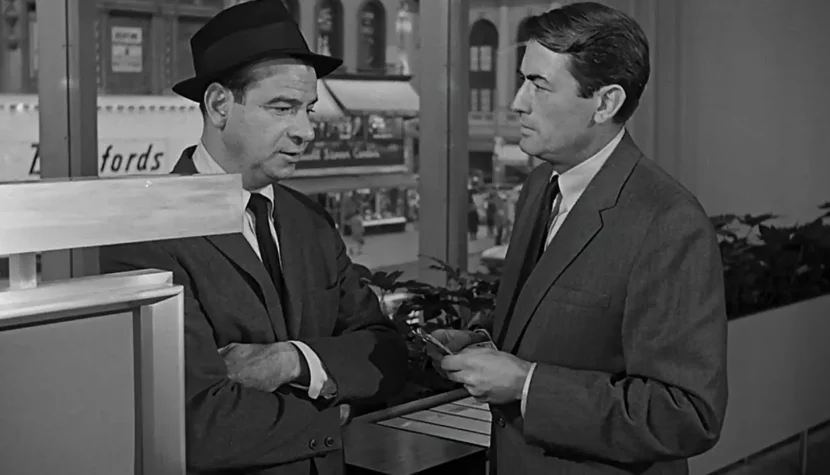MIRAGE. Complex crime puzzle

“Mirage” is an optical illusion where non-existent images appear before one’s eyes. It most commonly occurs in the desert, where an exhausted traveler, with eyes fatigued from the sun, sees lush vegetation, a city, or simply a spring to quench their thirst. But “Mirage” by Edward Dmytryk isn’t a film about wandering through the desert. It’s a classic thriller about the intricacies of the mind. One can never know which events will linger in memory for a long time. Sometimes, a situation, conversation, or movie fades from memory within weeks, but there are events that we remember even after 20 years. Can a person decide what they want to remember, or are there other factors beyond their control?
The first shot of the film shows New York skyscrapers, and in one of them, a power outage occurs—lights go out, and it’s time for a “Braille system” party. One of the residents, David Stillwell, has to descend 27 floors to exit the building. The first mirage he sees is a staircase leading four levels underground—only to discover that these stairs and additional levels don’t actually exist in the building. Gradually, other strange facts come to light, like the revelation that the company where he worked for the past two years doesn’t exist at all. But the strangest thing is that he doesn’t remember what he did before taking that job. When he describes his problem to a doctor, the doctor assumes he’s lying, because such a type of amnesia doesn’t exist (it’s impossible that he could have been unaware of his memory loss for two years). So, what’s going on? Why isn’t David Stillwell functioning like a normal person—why doesn’t he remember what he should, and why doesn’t he see what others do?

After “Charade” (1963), screenwriter Peter Stone crafted another complex crime puzzle. “Mirage” is like the human mind, filled with fragments of information and scraps of memory that need to be pieced together. The protagonist must face his problems alone because the answers to his questions are locked in his own head. No one will tell him what’s going on until he digs out the necessary information from the recesses of his memory. What made him forget? Did he suffer a severe fall, experience a shock that damaged his brain, or is he just pretending to avoid responsibility for his mistakes? Is he connected to the power outage in the building and the mysterious suicide of a certain financier? The strength of many thrillers lies in the fact that all pieces of the puzzle must fit together, and it seems that there are no unnecessary pieces here. Every detail must be important for uncovering the truth to make sense.
The film reveals similarities with two of Hitchcock‘s psychothrillers that deal with amnesia: “Spellbound” (1945) and “Marnie” (1964). To emphasize this connection, actors from those films were cast. Gregory Peck, with minimal means, created the character of a confused and astonished man caught up in bizarre events, trying step by step to discover the truth. His co-star was supposed to be Tippi Hedren, but Hitchcock had other plans for her. This gave Diane Baker, known for her supporting role in “Marnie”, a chance. In Dmytryk’s film, she built a character with a hidden inner world, leaving the audience to wonder whether she is a devious fraud or a helpless pawn being controlled. Walter Matthau, as Ted Caselle, deserves special mention as a second-tier private detective trying to prove his worth—modest, humorous, sharp, and vigilant. He isn’t indifferent to the audience—they root for him to solve this intricate puzzle.
In studies of American cinema, Edward Dmytryk’s name often appears in connection with the anti-communist witch hunt of the late 1940s and early 1950s. Dmytryk spent six months in prison for his beliefs. Joining the Communist Party during the war was a form of protest against Nazi terror, but after the war, communists began to be seen in the U.S. as enemies of the American way of life. Reality is constructed in such a way that situations can change from one minute to the next: former friends can become enemies and vice versa, and calm individuals can shed their masks, revealing their dark sides. From this kind of thinking, the thriller genre emerged—in this genre, the line between good and evil is thin, and anyone can cross it. Alfred Hitchcock was the master of the thriller, a widely repeated opinion with little opposition. However, other filmmakers also created films in the Hitchcockian spirit.

“Mirage” contains several excellent ideas, such as the motif of a watermelon smashing to the ground. The opening scenes, set in darkness, are brilliant. Many of the effects, unnoticeable at first glance, were created by Albert Whitlock, a matte painting specialist who worked with Hitchcock for many years. The music was composed by the legendary trumpeter Quincy Jones and is almost imperceptible, blending perfectly into the background of the story. Cinematographer Joseph MacDonald had more room to shine, creating a series of intriguing visuals that captured the twisty nature of this story about the labyrinths of the human mind. Edward Dmytryk, who directed films across various genres, handled the thriller well. Using a screenplay that includes elements of noir and psychological drama, he created a hypnotic, puzzling, and highly recommended film.

